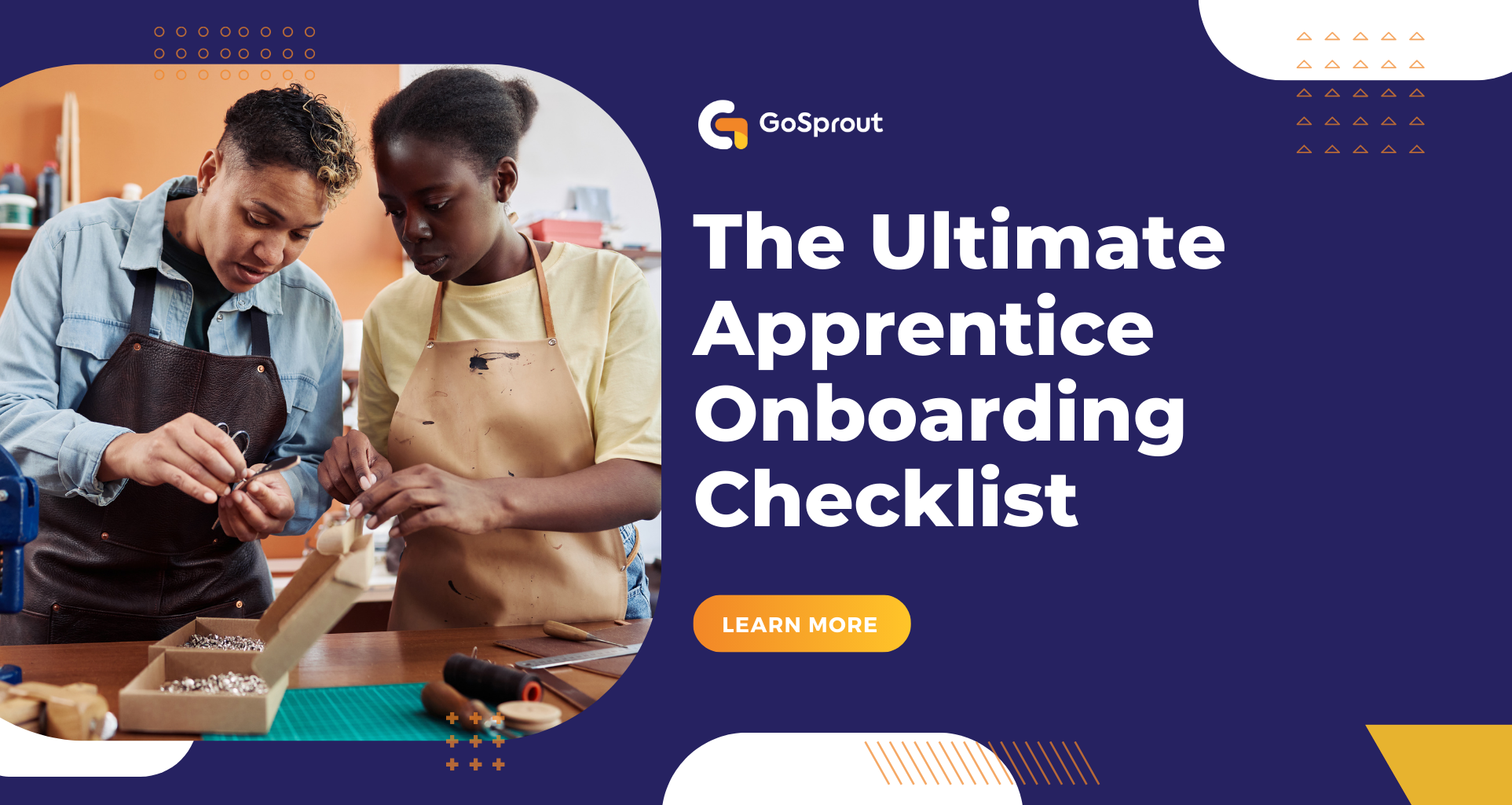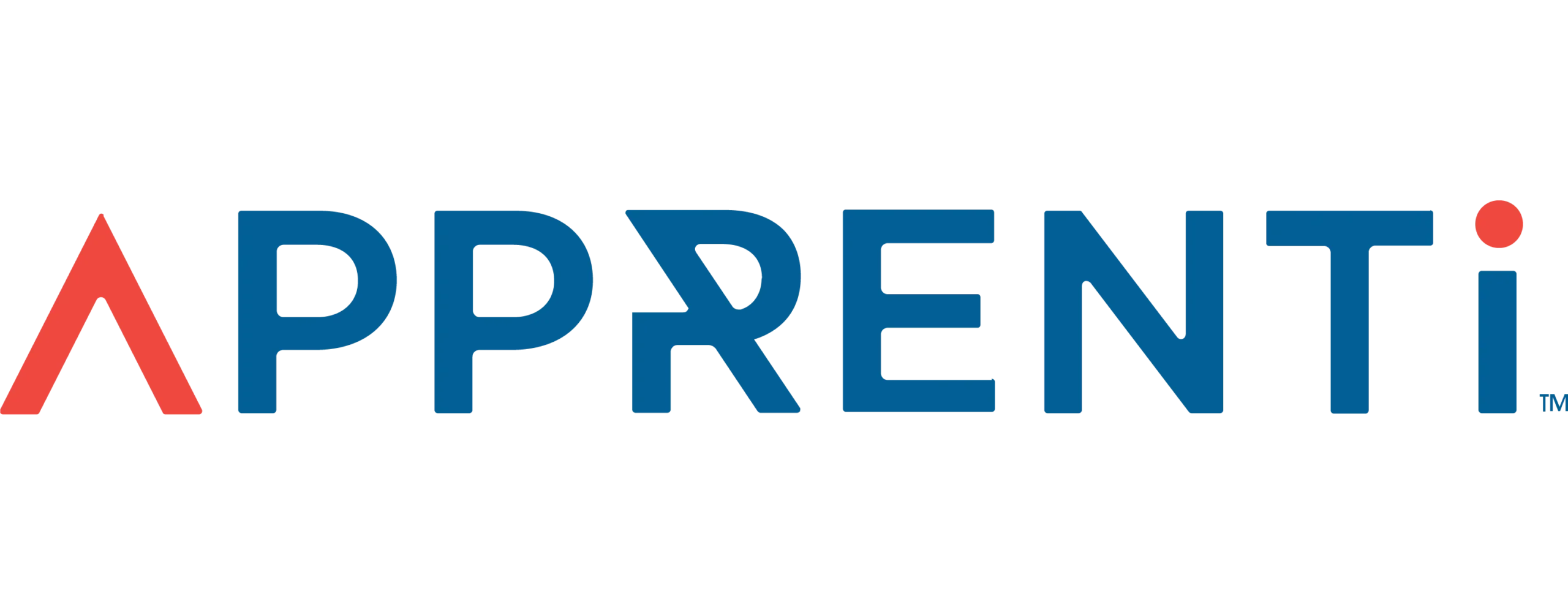Article Summary
- Create a welcoming environment from day one to build trust and reduce early attrition in your apprentice onboarding process.
- Use clear checklists and achievable milestones to guide apprentices and track their progress effectively.
- Tailor communication and support strategies to meet the specific needs and expectations of different apprentice demographics, like Gen Z.
- Leverage technology to streamline communication, feedback, and progress monitoring for all stakeholders involved.
- Foster a sense of belonging by integrating apprentices into the team culture and celebrating their achievements.
Want to Learn More About Your Registered Apprenticeship Opportunities?
BOOK A FREE CONSULTATION
Let’s Talk About Why New Apprentices Need Special Care
Bringing a new apprentice onboard is a fantastic opportunity – for them and for your company. It’s a chance to mold talent, close skills gaps, and maybe even change someone’s life trajectory. But let’s be real, starting any new role can be daunting, especially for someone potentially new to the professional world. That first impression and the initial support structure are absolutely critical for apprentice onboarding success. Setting the right tone from the start significantly impacts retention and productivity.
Build trust through mentorship
Pairing a new apprentice with a dedicated mentor (journeyworker) or buddy is invaluable. This isn’t just about showing them the ropes; it’s about creating a safe space for questions (even the ‘silly’ ones) and building a human connection. A good mentor provides guidance, support, and helps the apprentice navigate the company culture, making them feel less alone and more integrated [4]. Think of it as providing a friendly guide for their journey.
Create clear daily schedules
Uncertainty breeds anxiety. Especially in the first few days and weeks, providing a clear schedule helps apprentices understand what’s expected of them. This doesn’t need to be rigid down to the minute, but knowing key tasks, meetings, and learning objectives for the day provides structure and reduces overwhelm. It helps them focus on learning and contributing, rather than worrying about what they should be doing.
Set achievable early wins
Nothing builds confidence like accomplishment. Design the initial phase of the apprenticeship with small, achievable tasks or learning goals. These early wins provide positive reinforcement, demonstrate progress, and help the apprentice feel capable and motivated. It shows them they can succeed in this new environment. Remember, the goal is steady progress, not immediate mastery.

Track progress with GoSprout
How do you know if your apprentice is hitting those milestones? You need a system. Using checklists of required competencies or skills helps make the apprentice accountable for their learning [1]. This is where having a dedicated platform comes in handy, allowing both the apprentice and the manager to clearly see progress, identify areas that require additional support, and ensure everything stays on track for timely graduation. Consistent tracking provides transparency and keeps everyone aligned.
Pro tip: Kick off the mentorship relationship with an informal coffee chat. This helps break the ice and establish rapport before diving into work tasks.

What Makes Gen Z Apprentices Different?
Today’s apprentices, often belonging to Gen Z, come with a unique set of expectations and experiences shaped by growing up in a digital world. Understanding these nuances is key to designing an apprentice onboarding program that resonates and retains them. They’re not just looking for a job; they’re looking for purpose, growth, and a workplace that aligns with their values.
Understand digital-first mindsets
This generation is digitally native. They expect information to be accessible, communication to be efficient (often preferring digital channels), and learning to incorporate technology. Clunky, paper-based processes or outdated training methods can be a major turn-off. Think mobile accessibility, interactive learning modules, and streamlined digital workflows.
Value work-life integration
Known as The Toolbelt Generation, Gen Z often prioritizes work-life balance, or perhaps more accurately, work-life integration. They value flexibility and appreciate employers who recognize their lives outside of work. While apprenticeships require dedication, acknowledging this preference through reasonable hours, clear boundaries, and supportive management can significantly boost morale and loyalty. Showing you respect their time fosters mutual respect.
Address career growth needs
Apprenticeships are fundamentally about skill development and career advancement. Gen Z is particularly focused on growth opportunities. Clearly outlining the skills they’ll acquire, the potential career paths within the company, and providing regular feedback on their development is crucial [3]. They want to see a future and understand how this apprenticeship fits into their long-term goals. Enhancing your program with specialized learning modules through services like Course Development can further demonstrate your commitment to their growth by providing custom courses tailored to employer needs.
Pro tip: Incorporate short video messages or digital welcome kits in your pre-boarding communication. This caters to their digital preferences and makes the welcome feel more personal.

Here’s How to Structure Your Apprenticeship Phases
A well-structured apprenticeship program acts like a roadmap, guiding the apprentice from novice to competent professional. Breaking the journey into distinct phases makes the learning process manageable and provides clear benchmarks for progress. Think of it like building blocks – each phase lays the foundation for the next level of skill and understanding. This structured approach is fundamental, whether comparing apprenticeships vs internships or focusing solely on your program.
Plan orientation carefully
The first phase, orientation (often the first day or week), is crucial for setting the stage. This goes beyond paperwork. It’s about:
- Introducing company culture and values.
- Clarifying job roles and expectations.
- Making key introductions to the team and mentor.
- Providing essential logistical information (like navigating the building or accessing systems).
- A smooth orientation reduces anxiety and helps the apprentice feel welcomed and prepared.
Design skill building blocks
Structure the core of the apprenticeship around progressive skill development. Each phase should focus on a defined set of competencies, moving from foundational knowledge to more complex tasks. Ensure a blend of theoretical learning (Related Training Instruction or RTI) and practical application (On-the-Job Training or OJT). This systematic approach ensures comprehensive skill acquisition.
Schedule regular checkpoints
Don’t wait until the end of a phase to assess progress. Build in regular checkpoints – weekly or bi-weekly – for feedback, questions, and adjustments [3]. These touchpoints allow you to catch potential issues early, provide timely support, and ensure the apprentice stays on track. Using a tool like the Apprenticeship Management Platform makes scheduling and documenting these checkpoints seamless, uniting employers, sponsors, schools, journeyworkers, and apprentices in one place for easy tracking of OJT and RTI.
Track certification progress
For Registered Apprenticeships, tracking progress towards specific certifications or credentials is vital. Ensure your structure includes clear milestones related to required training hours, competency assessments, and any necessary exams. This provides tangible goals for the apprentice and ensures compliance requirements are met for successful program completion and graduation.
Pro tip: Use a visual timeline or flowchart to illustrate the different phases and milestones of the apprenticeship. This helps apprentices see the bigger picture and understand their progression.
Let’s Define Clear Expectations for Everyone
Ambiguity is the enemy of a successful apprenticeship. Everyone involved – the apprentice, the mentor, the manager, even the broader team – needs to understand their roles, responsibilities, and what success looks like. Setting clear expectations from the outset prevents confusion, minimizes frustration, and creates a foundation for accountability [4]. This clarity is a cornerstone of understanding the benefits of apprenticeships.
Outline apprentice responsibilities
What is the apprentice expected to do, learn, and achieve? Be specific.
- Detail daily tasks and learning objectives.
- Outline expectations for participation in training (both OJT and RTI).
- Explain how and when they should ask for help.
- Clarify professional conduct standards.
- Providing this roadmap empowers the apprentice to take ownership of their learning journey.
Detail mentor commitments
Mentorship is a commitment, not just a title. Clearly define what is expected of mentors or journeyworkers:
- Frequency and duration of check-ins.
- Specific skills or processes they are responsible for teaching.
- How they should provide feedback.
- Their role in assessing competency.
- Setting these expectations ensures mentors are equipped and prepared to provide effective guidance.
Establish program milestones
Break down the overall apprenticeship goals into clear, measurable milestones. These could be tied to specific skills mastered, projects completed, or hours logged. Having defined milestones provides tangible targets for the apprentice and allows managers to track progress effectively. If you’re unsure how to structure these or identify potential funding, exploring Workforce Planning & Consulting can be beneficial, as GoSprout’s team helps employers understand program setup, resources, grants, and incentives.
Pro tip: Create a simple ‘Roles & Responsibilities’ matrix document that clearly lists who is responsible for what in the apprenticeship program. Share this with everyone involved during onboarding.
Here’s Why Communication Makes Programs Succeed
Effective communication is the glue that holds an apprenticeship program together. It ensures everyone is informed, aligned, and supported throughout the apprentice’s journey. Poor communication, on the other hand, leads to misunderstandings, missed opportunities, and potential disengagement. Fostering an environment of open, regular communication is non-negotiable for apprentice onboarding success.
Use GoSprout’s messaging tools
Leveraging technology can significantly streamline communication. Platforms designed for apprenticeship management often include built-in messaging features. These tools keep conversations organized, documented, and easily accessible to relevant parties (apprentice, mentor, manager, sponsor). This avoids scattered emails or missed messages and creates a central hub for program-related communication.
Schedule weekly check-ins
Formal, scheduled check-ins are crucial, but don’t underestimate the power of regular, informal communication. Encourage mentors and managers to have brief, weekly touchpoints with apprentices [3]. These sessions are opportunities to:
- Discuss progress and challenges.
- Answer questions.
- Provide timely feedback.
- Simply build rapport. Consistent check-ins make apprentices feel supported and heard.
Document feedback clearly
Feedback is essential for growth, but it needs to be clear, specific, and documented. Avoid vague comments. Instead, provide concrete examples of what the apprentice did well and areas for improvement. Documenting this feedback (ideally within a management system) creates a record of progress and ensures consistency. The Apprenticeship App is designed for this, putting progress tracking and feedback directly in the apprentice’s hands.
Celebrate small victories
Communication isn’t just about addressing problems; it’s also about recognizing success. Acknowledge milestones achieved, skills mastered, and positive contributions made by the apprentice. Celebrating these small wins boosts morale, reinforces positive behavior, and shows the apprentice their efforts are valued. You can share successes within the team or even highlight apprentice achievements on platforms like the GoSprout LinkedIn page (with permission, of course!).
Pro tip: Establish preferred communication channels and expected response times early on. This manages expectations for both apprentices and managers.
Conclusion: Your Complete Apprentice Onboarding Success Plan
Creating a delightful and effective apprentice onboarding experience isn’t about grand gestures; it’s about thoughtful planning, clear communication, and consistent support. By focusing on building trust, setting clear expectations, structuring the learning journey, and leveraging the right tools, you significantly increase the chances of your apprentices not just completing the program, but thriving within your organization.
Remember, a successful apprenticeship is a win-win-win: the apprentice gains valuable skills and a career pathway, your company develops loyal and skilled talent, and together we help close the nation’s skills gap. Investing in a strong onboarding process is investing in your future workforce. Let’s work together to make every apprenticeship journey a success story.
Frequently Asked Questions
- Q: How long should the apprentice onboarding process last?
- A: While the most intensive onboarding happens in the first few weeks, the process of integration, skill development, and cultural acclimation typically extends through the first three to six months, aligning with probationary periods [8].
- Q: What’s the single most important factor for apprentice retention during onboarding?
- A: While many factors contribute, creating a strong sense of belonging and providing consistent support through mentorship and clear communication are arguably most critical for early retention [3, 4].
- Q: How can I measure the success of my apprentice onboarding program?
- A: Key metrics include apprentice satisfaction (through surveys), task completion rates, milestone achievement, mentor feedback, and ultimately, program completion rates and long-term retention post-apprenticeship.
- Q: Should onboarding differ for remote vs. in-person apprentices?
- A: The core principles remain the same, but the delivery methods need adaptation. Remote onboarding requires more intentional effort in virtual team introductions, digital communication strategies, and ensuring access to necessary tools and support [8].
- Q: How can software help with apprentice onboarding?
- A: Software like GoSprout centralizes communication, tracks progress against OJT and RTI requirements, manages documentation, facilitates feedback, and provides visibility for all stakeholders, streamlining the entire process.
References
- mospace.umsystem.edu. Principles for designing active and adaptable onboarding experiences for library employees. https://mospace.umsystem.edu/xmlui/handle/10355/68668
- linkedin.com. The Ultimate Employee Onboarding Checklist: Best Practices for …. https://www.linkedin.com/pulse/ultimate-employee-onboarding-checklist-best-practices-md-ali-ahsan-oudwc
- touchstay.com. The ultimate employee onboarding checklist | Touch Stay | Touchstay. https://touchstay.com/blog/employee-onboarding-checklist
- talentlms.com. The Definitive New Hire Onboarding Checklist and Guide – TalentLMS. https://www.talentlms.com/blog/new-hire-onboarding-checklist/















